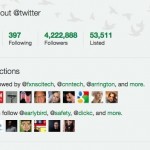 As Twitter has risen as a social network, so too have the number of studies and articles proposing the secrets to Twitter success. This attention is perhaps not surprising given the considerable influence the site has on the way ideas spread.
As Twitter has risen as a social network, so too have the number of studies and articles proposing the secrets to Twitter success. This attention is perhaps not surprising given the considerable influence the site has on the way ideas spread.
Central to much of this research is the kind of connections you have with people on the site. Is it better to have deep relationships or lots of shallow ones? A new paper set out to provide the answer with a particular focus on what kind of connections will spread tweets onto their networks.
The researchers analysed tweets across five day periods to better understand the relationship between people when a retweet occurred. It’s believed to be the first study of this kind, and as such has some valuable insight into how we go about building our network on the site.
It emerged that when both parties followed each other (ie a two way relationship), there was a 6% chance of either party retweeting a comment from the other. When the relationship was only one-way however, that probability rose to 9.1%, which is a boost of over 50%.
“We found that people with weak ties, such as those who only have a one-way relationship on Twitter – who don’t both follow each other – are more likely to retweet,” says Zhan Michael Shi, assistant professor in the W. P. Carey School of Business, one of the paper’s authors. “We believe the retweeters are sharing the information because they think it will boost their reputation and influence by providing something new. People with stronger ties might not retweet because they believe their followers already know the details, and/or they may have communicated with each other in other ways.”
“Twitter is incredibly popular and fast-growing as a social medium, with more than 500 million registered users worldwide by April 2012,” Shi says. “It’s a combination of a broadcasting service and a social network, so our results aren’t necessarily translatable to more pure social networks, such as Facebook. However, we think the new information is going to be very useful to people like social-media managers and marketers trying to understand how information is spread via social-broadcasting networks like Twitter.”
So the moral of the story is that if you want folks to retweet what you write, you have a better chance if the relationship with them is one way.
Hey, Adi – I don't doubt that a lot of research has gone into this paper. My personal experience has been very different. I find that even apart from Triberr the more I share fellow bloggers tweets, the more tweets I get from them, So my experience has been that collaboration works really well. What about you? What has your experience been? Do you agree with this paper?
I'm inclined to think that Triberr is, whilst fantastic, something of an anomaly in how a lot of folks tend to use Twitter. It's great to build those relationships, but it doesn't always happen. I mean I rarely follow anyone now, preferring instead to add interesting people to lists that allow me to segment them, or use something like Triberr to filter again according to groups. Much more effective at finding good content that way imo.
I suspect the research may also have been skewed a little by the well known users on Twitter who inevitably have a lot of followers and get a lot of retweets, but don't follow many people themselves.
Even though it may indeed seem counter-intuitive, I can see how this 50% jump in retweeting occurs when two people don't necessarily follow each other. Just take a look at the top 3 most retweeted posts of 2013: they all relate to celebrities. With over 400,000 retweets, this can only happen when a known & young actor dies (as was the case with Glee actor Cory Monteith) and his girlfriend tweets a message. Everybody wants a piece of this "news" and share it with their own network. Same thing with actor Paul Walker died and, lo and behold, when One Direction member Niall Horan turned 20. In all three cases, they are three individuals with huge following bases, not reciprocated.
Interesting finding, though. Cheers,
Yes, I think that's exactly it. What would be interesting to know is quite how much those instances skew the stats, and what things are like for the majority of us.
Hmm, I have to question the research. I wonder how much the Stephen Fry's of this world skewed the results.